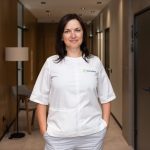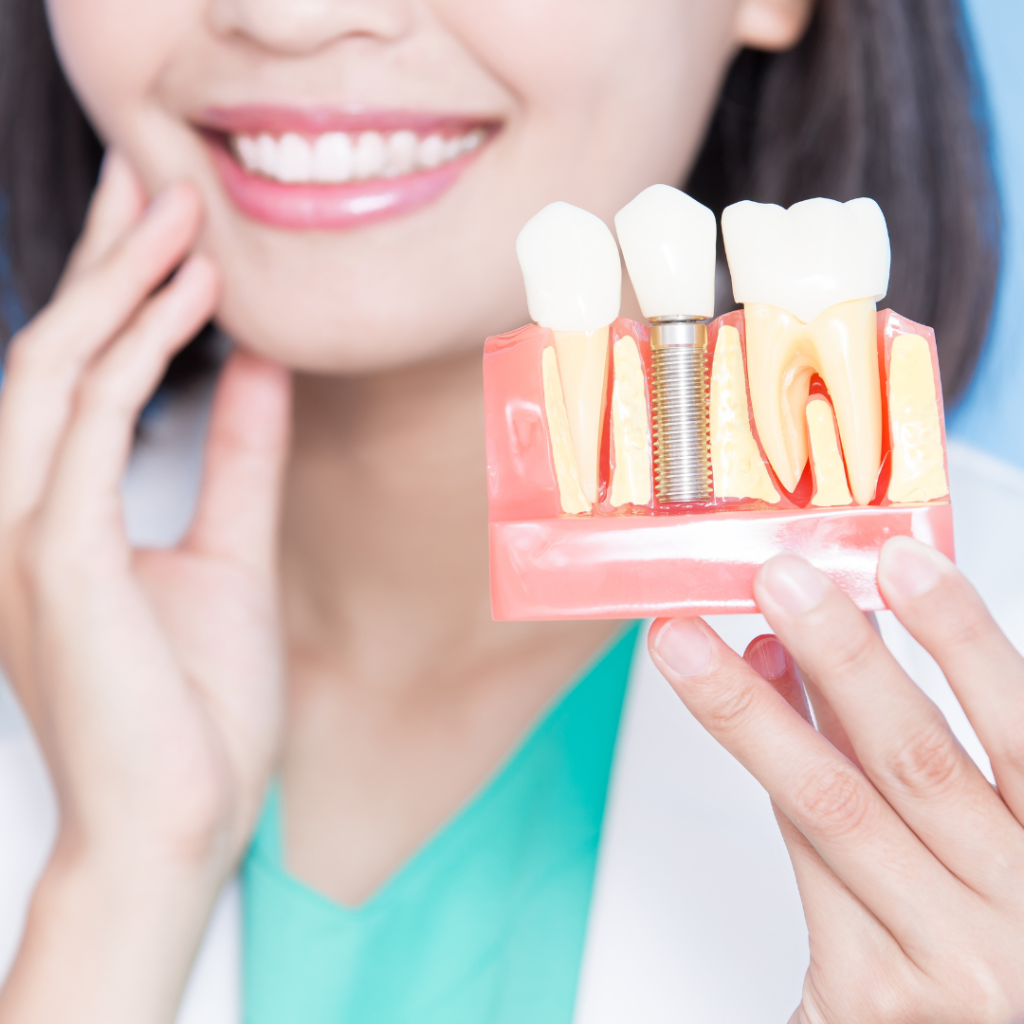Mesial occlusion — modern treatment in Warsaw
A protruding lower jaw, abrasion of the front teeth and speech disorders are the consequences of a mesial occlusion, which is often detected only in adolescence. The pathology changes the facial profile and function of the temporomandibular joint (TMJ), provoking pain, crunching and restriction of mouth opening.
According to studies, patients with a mesial occlusion often have asymmetry of chewing load and a decrease in the contact function of the teeth (occlusion), which indicates a violation of the maxillofacial system. Ignoring the problem leads to compensatory overstrain of the neck muscles, accelerated abrasion of the incisors and overloading of the anterior periodontal ligament. Untimely intervention threatens with gingival recession, wedge-shaped defects and dystrophic changes in bone tissue.
Treatment of mesial occlusion at Astra Dent begins with a comprehensive diagnosis: teleradiography in two projections, digital photo protocol, analysis of the jaw ratio in three planes and modeling of the functional occlusion template. CT scanning of the temporomandibular joint, registration of the central ratio and electromyography are mandatory. Due to this, the doctor gets an idea of the clinical situation and can predict the reaction of the musculoskeletal system to orthodontic intervention.
Why do patients choose Astra Dent Warsaw for the treatment and diagnosis of mesial occlusion?
Correction of mesial occlusion is a complex work with the musculoskeletal system of the face. The accuracy of diagnosis, adaptation of methods to the patient's anatomy and control over changes at each stage of treatment are of decisive importance.
Advantages of medial occlusion correction at Astra Dent:
- Experienced orthodontists. The medical center staff includes specialists with 15 years of experience in the treatment of pathological occlusions, who have been trained in European orthodontic schools. They have mastered the techniques of working with removable and fixed systems, conduct diagnostics taking into account the balance between the skull, jaws and fascia — connective tissue structures that transmit muscle tension and affect posture and bite.
- Modern systems for correcting occlusion. The treatment uses self-ligating braces, aligners with biomechanical control of tooth movement, distractors and orthopedic devices to stimulate jaw growth in children and adolescents. The choice of system is based on 3D modeling of the jaws and a preliminary analysis of the dynamics of occlusion.
- Transparent pricing and convenient payment methods. The patient receives a detailed treatment plan with fixed prices for each stage: from diagnosis to completion of orthodontic correction. Payment is possible in convenient ways – at the cash desk, online or directly from a Polish bank account.
- Comfortable environment and support in Ukrainian. Astra Dent in Warsaw employs administrators and doctors who speak Ukrainian, so patients do not have to explain details due to the language barrier. Visits are scheduled at a convenient time, and each stage of treatment is accompanied by explanations without complicated terms.
Patients who turn to Astra Dent can count on comprehensive support — from the first visit to the final stabilization of the result.
Causes of mesial bite
Dozens of factors influence the position of the jaws — genetic predisposition, mechanical stress, childhood habits. In most cases, mesial bite is formed gradually, and you can notice that the lower jaw protrudes forward only when changing milk teeth to permanent ones. In order to properly plan treatment, you first need to find out the causes of the pathology.
- Heredity. If one of the parents has a mesial bite or a shortened upper jaw, the likelihood of inheriting such an anomaly doubles. Genetically determined bone growth parameters are often detected at the stage of eruption of the first incisors.
- Habits. Prolonged thumb sucking, mouth breathing, sticking the tongue out between the teeth, or incorrect posture during sleep change the direction of jaw growth. Excessive muscle pressure and load on the front of the dentition can gradually shift the lower jaw forward.
- Early tooth loss. Loss of deciduous molars or front teeth before the occlusion is complete leads to displacement of the dentition. Due to the lack of chewing contact, the jaw changes the direction of growth and occupies an incorrect position in the bite.
- Jaw development disorders. Asymmetrical growth or delayed development of the upper jaw is accompanied by compensatory protrusion of the lower jaw. Usually, changes are associated with endocrine disorders, chronic diseases, microanomalies of the craniofacial area.
Specialists analyze the provoking factors in a complex, taking into account both the current clinical picture and the prerequisites for the formation of a medial bite. Due to this, Astra Dent develops an individual correction path that prevents repeated disorders in the functioning of the dentofacial system.
How is the treatment of mesial occlusion at Astra Dent Warsaw performed?
Correcting an occlusion requires a step-by-step approach with precise planning of the correction scheme, monitoring and understanding of the relationship between teeth, jaws and muscles. The Astra Dent team uses a comprehensive approach: treatment begins with a thorough diagnosis and ends with stabilization of the result, taking into account age, growth of bone structures and individual reaction of the body.
How does diagnostics begin
Determining the type of occlusion is possible only after a comprehensive assessment of the anatomy of the jaws, muscle tone and position of the teeth in three planes. A consultation at Astra Dent is not limited to a brief examination, but involves a functional analysis of all elements of the chewing apparatus that affect the occlusion:
- Visual examination and functional testing. The doctor assesses the symmetry of the face, mouth opening, jaw ratio at rest, during speech and chewing.
- Digital photography of the face and occlusion. Photo fixation is required for analysis of the profile, proportions and changes before and after treatment.
- Panoramic orthopantomogram (OPTG). Allows the dentist to assess the general condition of the teeth, the presence of impacted or supernumerary elements, and bone pathologies.
- Teleradiography (TRG) in lateral projection. Used to construct cephalometric analyses, determine the skeletal class of the bite and the angle of inclination of the jaws.
- Clarifying computed tomography (CT) of the temporomandibular joint. Used in complex cases to assess the position of the joint heads, the symmetry of the articular fossa, and the presence of deformations.
- Electromyography of the masticatory muscles. Allows you to record the functional imbalance of the muscles, which often accompanies the mesial bite and affects the stability of the result.
Thanks to a detailed examination and functional tests, the orthodontist can predict how the system will react to the load during correction, and draw up a physiologically based treatment plan.
How an individual treatment plan is formed
Even with a similar clinical picture, the causes, anatomical features and the response of the jaws to the load differ significantly. Therefore, after diagnosis, a personalized treatment plan is drawn up, which takes into account the type of bite and the functional parameters of the maxillofacial system. During the planning process, the orthodontist analyzes:
- Type and degree of pathology. It is determined whether the bite is skeletal, dental or combined, whether orthodontic intervention can be limited or surgery is required.
- Balance between the jaws and the position of the dental arches. The shape of the arches, symmetry, tongue pressure, displacement in the horizontal and vertical planes are analyzed.
- Optimal treatment system. Braces, aligners or functional appliances are selected taking into account age, type of pathology and muscle reactivity.
- Predicted duration of treatment. Approximate terms are based on the speed of tissue restructuring, growth characteristics and biomechanical modeling.
- Control and monitoring scheme. The frequency of follow-up visits, types of additional examinations and the form of retention after the active stage is determined.
As a result, the patient receives a structured plan that prescribes all stages, methods, expected changes and deadlines.
Treatment of mesial occlusion in children
At an early age, bone structures are actively growing, so correction of the occlusion occurs mainly through correction of breathing, chewing and tongue position. Astra Dent doctors use methods that form the correct muscle reflexes to prevent relapses in the future:
- Myofunctional trainer systems. Soft silicone mouthguards train the correct position of the tongue, lips and jaws, normalizing breathing through the nose.
- Plates with active elements. Removable appliances set the direction of growth of the upper or lower jaw using screws, springs or arches.
- Appliances with lingual stops. Help get rid of the habit of sticking the tongue between the teeth, which is often the cause of the formation of mesial occlusion.
- Functional night splints. Used to relax the chewing muscles and reduce pressure on the front teeth during sleep.
Early treatment prevents complex orthodontic interventions in the future and creates conditions for the natural formation of a symmetrical bite during the period of active growth of the child.
Treatment options for adolescents and adults
After the age of 12, jaw growth slows down, so Astra Dent specialists focus on moving teeth and correcting jaw position through fixed or removable orthodontic systems. The treatment approach is based on digital prediction of the result, the biomechanics of tooth movement and functional stability of the joints:
- Brace systems. Self-ligating structures, classic metal or aesthetic ceramic options, as well as lingual braces that are fixed on the inner side of the dentition are used.
- Aligners (Spark, Invisalign). Transparent trays made based on a 3D scan of the jaws gradually move the teeth with high accuracy and minimal discomfort.
- Orthognathic surgery. In case of pronounced skeletal disproportions, surgical alignment of the jaws is performed with subsequent intermaxillary fixation and retention control.
The selection of the system depends on the anatomy, lifestyle of the patient, the expected aesthetic result and medical indications. In complex cases, orthodontists collaborate with maxillofacial surgeons to achieve a stable functional and visual effect.
Treatment control and stabilization of the result
In order for the result of the therapy to be long-lasting, it is necessary to monitor the course of changes and adjust the action plan in a timely manner. Astra Dent doctors guide the patient at each stage – from the activation of the orthodontic system to the stabilization phase after removing the devices. During the control process, the following take place:
- Monthly examinations. The dentist checks the position of the teeth, adaptation to the device and the condition of the soft tissues of the oral cavity.
- Correction of the orthodontic system. If necessary, the arches are replaced, the elements are activated or new aligners are issued.
- Control visualization. A digital scan or repeated images are performed to compare the intermediate result with the initial plan.
- Appointment of the retention phase. After the active treatment is completed, mouthguards, retainers or stabilizing splints are installed to maintain the new position of the teeth.
Stabilization of the result is no less important than the correction. During this period, the final restructuring of the ligamentous apparatus and the adaptation of the muscles to the new occlusion take place.
How to make an appointment at Astra Dent Warsaw?
The earlier you start treatment, the easier it is to correct the mesial bite. You can make an appointment at Astra Dent in Warsaw in a convenient way:
- by phone: +48 533 599 552
- by e-mail: info@astradent.pl
- via the website: fill out a short online form.
The dental center is open every day, so you can choose a convenient time for a visit, even with a busy schedule. It only takes a few minutes to make an appointment and start correcting your bite without risk to your joints, muscles and teeth.

Last update:
17 July 2025, 20:49





















